Producing pigs to comply with ever-increasing environmental restraints
Published: August 29, 2007
By: DAVE HENMAN - QAF Meat Industries, Corowa, New South Wales, Australia (Courtesy of Alltech Inc.)
Governmental regulation on the outputs of piggery systems in Australia was also thought to be the next stage of control. An example of this was to be the introduction of ‘load-based licensing’ in New South Wales. The pig industry then began working with the environmental protection agency (EPA) to address the issues head on; and this has paid dividends in the form of reducing the need for governmental regulation as most enterprises were advancing faster than government requirements dictated.
Piggery enterprises generate a significant amount of waste in terms of biodegradable solids, nutrients and salt. The characteristics and nutrient content of the waste excreted by a pig will largely be determined by the composition of the diet and the amount that is utilised by the animal.
The traditional aim of formulating pig diets is to achieve maximum growth rates at minimum cost. This is achieved by setting the minimum nutrient specification such that the majority of pigs achieve maximum growth rates.
Thus the majority of animals will receive nutrients in excess of requirements, which are excreted. This approach to formulation is no longer acceptable. Environmental nutrition aims to reduce the amount of waste produced and is defined as ‘the concept of formulating cost-effective diets and feeding animals to meet their minimum mineral needs for acceptable performance, reproduction, and carcass quality with minimal excretion of minerals’ (Kornegay and Harper, 1997).
Nitrogen and the macrominerals
The nutrients that are considered of major importance in effluent systems are nitrogen, phosphorous and potassium.
A mass balance spreadsheet developed in Australia ‘PIGBAL’ was run to investigate the effect of diet on the nutrient excretion of grower pigs. Typical grower diets for Queensland, NSW, South Australia and Western Australia were formulated for a 1000 pig grower unit (10 to 16 weeks of age). Feed ingested was set at 1.5 kg/pig/day, with a 10% allowance for feed wastage. Figure 1 shows that in all cases the majority of the nutrients are excreted. Nitrogen excretion ranges from 56.1 to 63.4%.
Phosphorous excretion ranges from 62.5 to 72.0%. Potassium excretion ranges from 77.6 to 82.7%.
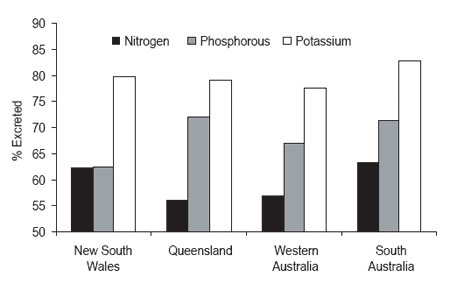
Figure 1.Amount of nitrogen, phosphorous and potassium excreted for four grower diets, using diets from four states.
Once the diets are formulated the method of feeding can significantly contribute to the level of excreted nutrients. Estimates of wastage (feed removed from the feeder but not consumed by the animal) range from 8 to 30% of the feed disappearance. The physical form of the diet can significantly influence the amount of feed wastage.
In the best systems, diets presented in mash form result in 15% feed wastage while pelleted diets produce 7% and liquid feeding systems would be expected to produce less than 4%. All these systems are dependent on the type of feeders used and whether the feeder is selected to match the diet form. Steam pelleting of diets is generally considered to increase the digestibility of dietary nutrients by 5%, dependent on the class of pig being fed. This digestibility advantage diminishes as the pig ages and is possibly nonexistent in sows.
The number of times that dietary specifications are changed during the life cycle of an animal can also significantly affect the amount of nutrients excreted. Before the advent of phase feeding, the relative decline in diet amino acid content with age was minimal and usually targeted to meet the higher requirements of younger animals. This generally results in massive oversupply of nutrients, especially nitrogen, which end up in the effluent systems of piggeries.
The development of phase feeding was a result of increasing efficiencies in terms of economic advantages with a significant side benefit of reducing excess nutrient excretion. The ultimate expression of phase feeding can be in liquid feeding or blending systems where blends can be changed every day to match changing animal requirements.
The recent area of advancement in the formulation of pig diets is the determination of available amino acid requirements with formulation of the diet based on the complete profile of available amino acids. This procedure has been greatly enhanced through the development of computer simulation models such as AUSPIG and ileal digestibility studies. The increased number and reduced cost of synthetic amino acids available to the feed industry has also allowed this science to progress rapidly. The end result is less nitrogen excreted into the effluent system.
Another area of focus in the pig industry at present centers around the choice of digestible energy density for growing and finishing pigs. The standard doctrine of choosing the lowest cost per megajoule of digestible energy does not take into account what is occurring from an environmental point of view and instead focuses on economic importance only. New work in this area has shown that there are production as well as environmental advantages to formulating high density digestible energy diets for finisher pigs.
Trace minerals
While the importance of the major nutrients nitrogen, phosphorous and potassium are uppermost in the mind of regulators, the trace mineral levels in effluent can play a major role in determining the capacity to utilize effluent in different disposal systems.
An example of this is the toxicity of copper to worms, where high levels can significantly reduce the viability of a worm farm. Trace mineral content of manure must also be managed if effluent utilization is to be maximized.
The trace mineral of major importance around the world is copper (Cu). Due to its non-antibiotic growth promotion properties it has been included in diets at the highest levels and contributes most of the trace mineral in piggery effluent systems.
Experiments have shown the growth responses to copper and its contribution to effluent systems. Table 1 shows the growth performance of pigs fed copper sulphate and Bioplex® forms of copper. The addition of copper sulphate and Bioplex® Cu to grower-finisher diets tended to improve growth rate by 5% and feed conversion by 3%.
There was no difference in performance between pigs given diets containing Bioplex® Cu at 100 ppm Cu and those given diets containing 200 ppm Cu from copper sulphate. These data tend to confirm results of many trials conducted around the world and allow us to commercially evaluate the cost effectiveness of alternative forms of copper.
Table 2 shows results of a study conducted at QAF Meat Industries in 1999 indicating how organic minerals can reduce the excretion of copper. This reduction in copper effluent level due to the lower amount of copper added to the diet suggests that we may also be able to achieve similar reductions with other trace minerals.
Table 1. Effects of diets containing two levels of copper sulphate or Bioplex® Cu on growth performance and carcass characteristics of male pigs from 28 kg to slaughter.
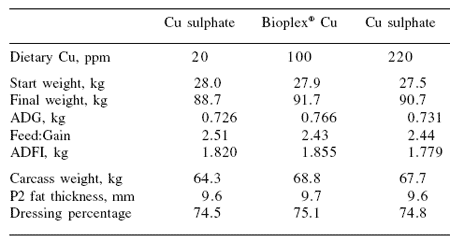
Table 2. Faecal copper content of growing pigs fed diets containing different levels and sources of copper.
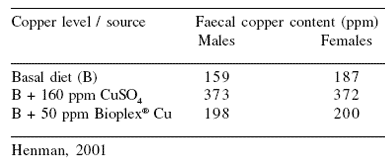
From an environmental point of view, taking advantage of the increase in bioavailability of organic trace mineral sources is a key to achieving the desired outcome of a smaller environmental footprint. Carlson (2001) has shown that as we reduce the amount of minerals added to the diet, we reduce the level of minerals in the effluent.
While we can lower the total level of mineral ions in the diet and thus in the faeces using the more bioavailable organic mineral sources, it is critical that pig performance be maintained. With this in mind we conducted an experiment at QAF Meat Industries with 600 10-week-old grower pigs selected over a 5-week period.
One pen of 20 male pigs and one pen of 20 female pigs were selected each week for each of the three dietary treatments. During the seventh week two faecal grab samples from each pen were collected for mineral analysis. The pigs remained in the pen for seven weeks after which each pen was randomly divided in half and moved to new accommodation such that there was a maximum of 10 pigs per pen for the remaining six weeks of the experiment.
Pen weights were recorded at the start of the experiment, at the grower/finisher transition, three weeks into the finisher phase and again at the end of the experiment. Feed intake was reconciled at each of these periods in order that an average feed intake and feed conversion for each period could be calculated. Dietary treatments differed in the inclusion of a trace mineral supplement (Table 3). Treatment A contained standard commercial levels of inorganic trace minerals and treatment B contained the same level of minerals but in organic form (Bioplex® minerals). The third treatment consisted of 25% the level of minerals as the other two treatments and in organic form (Bioplex® minerals and Sel-Plex® organic selenium).
Physical performance of the pigs was unaffected by treatment (Table 4). The faecal output of minerals at the end of the grower and start of the finisher phase indicated a significant reduction in iron and manganese excreted when the diets contained organic trace minerals (Table 5). When the mineral levels were reduced to 25% of the standard commercial levels and in Bioplex® form there was a significant reduction in all mineral excretion levels.
The results of this experiment indicate that organic minerals can replace inorganic minerals at 25% the levels of the inorganic minerals without an impediment to performance over the grower/finisher period. The replacement of the inorganic minerals with 25% the level of organic minerals is approximately the same in cost per tonne of diet with the advantage of a 20% reduction in effluent levels of trace minerals.
Conclusions
The concept of environmental nutrition via the holistic approach is the most important frontier in nutritional management and research. Responding to increasing pressures on all livestock operations to become sustainable economically and environmentally is the only way to ensure our survival into the future.
Table 3. The inclusion level (g/T) of minerals and forms used to examine the performance of pigs from 10-23 weeks of age.
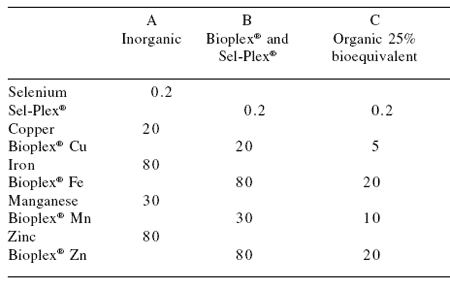
Table 4. Performance of male and female pigs from 10-23 weeks of age fed diets containing commercial levels of inorganic or organic minerals or a diet containing 25% of the commercial levels.

Table 5. Faecal mineral levels (ppm) of pigs fed respective treatment diets sampled at the end of the grower phase of production.
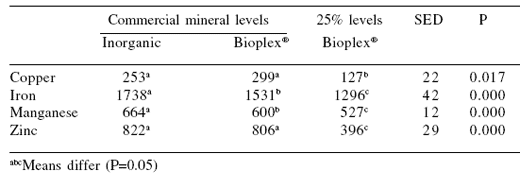
References
Carlson, M.S. 2001. Dietary trace elements of the growing pig. In: Concepts in Pig Science 2001 (T.P. Lyons and D.J.A. Cole, eds). Nottingham University Press, UK, pp. 147-156.
Henman, D. 2001. Organic mineral supplements in pig nutrition: performance and meat quality, reproduction and environmental responses. In: Biotechnology in the Feed Industry, Proceedings of the 18th Annual Symposium (T.P. Lyons and K.A. Jacques, eds.), Nottingham University Press, UK.
Kornegay, E.T. and A.F. Harper. 1997. Environmental nutrition: Nutrient management strategies to reduce nutrient excretion of swine. Prof. Anim. Sci. 13:99-111.
Related topics:
Recommend
Comment
Share

Would you like to discuss another topic? Create a new post to engage with experts in the community.





